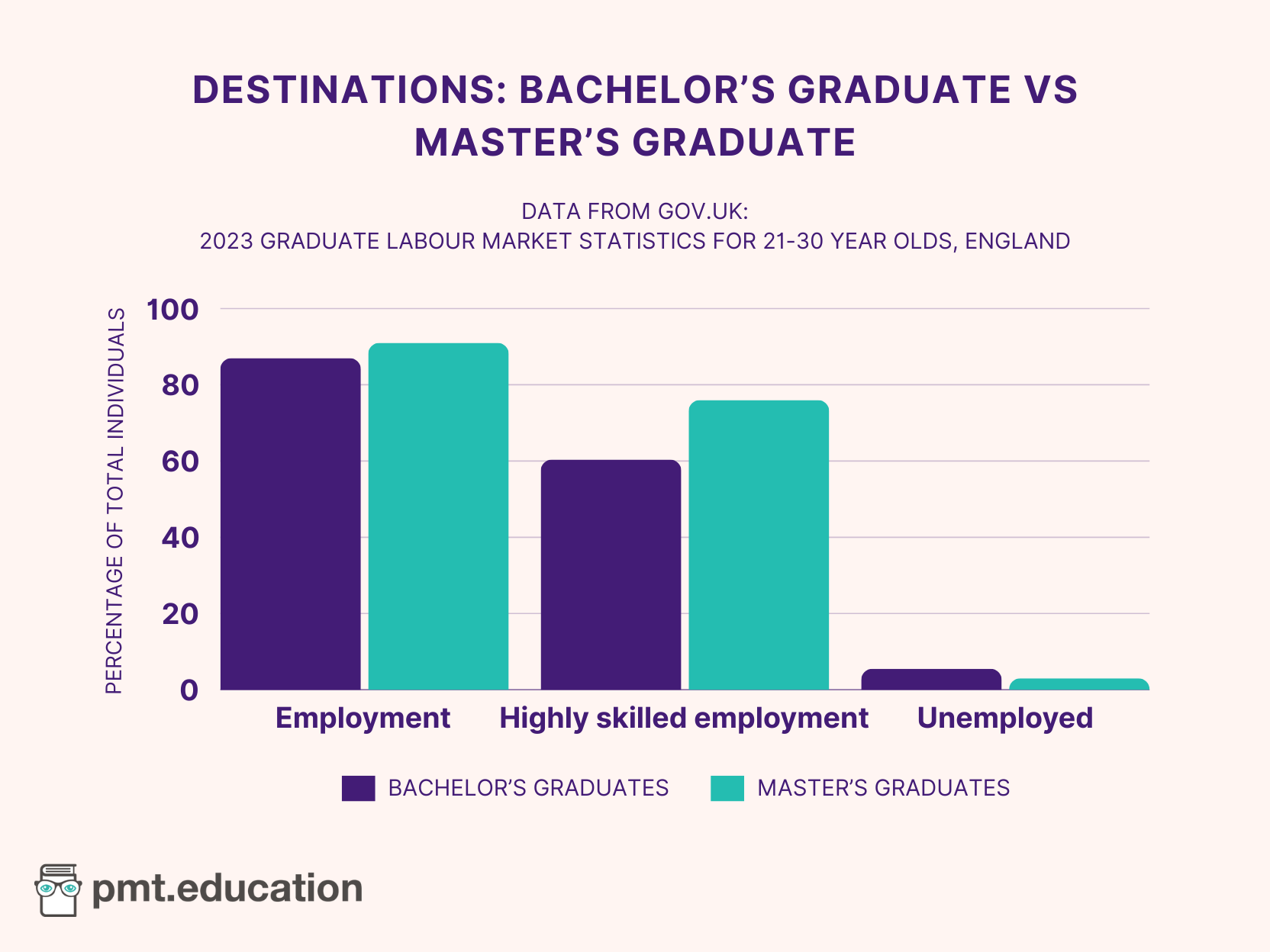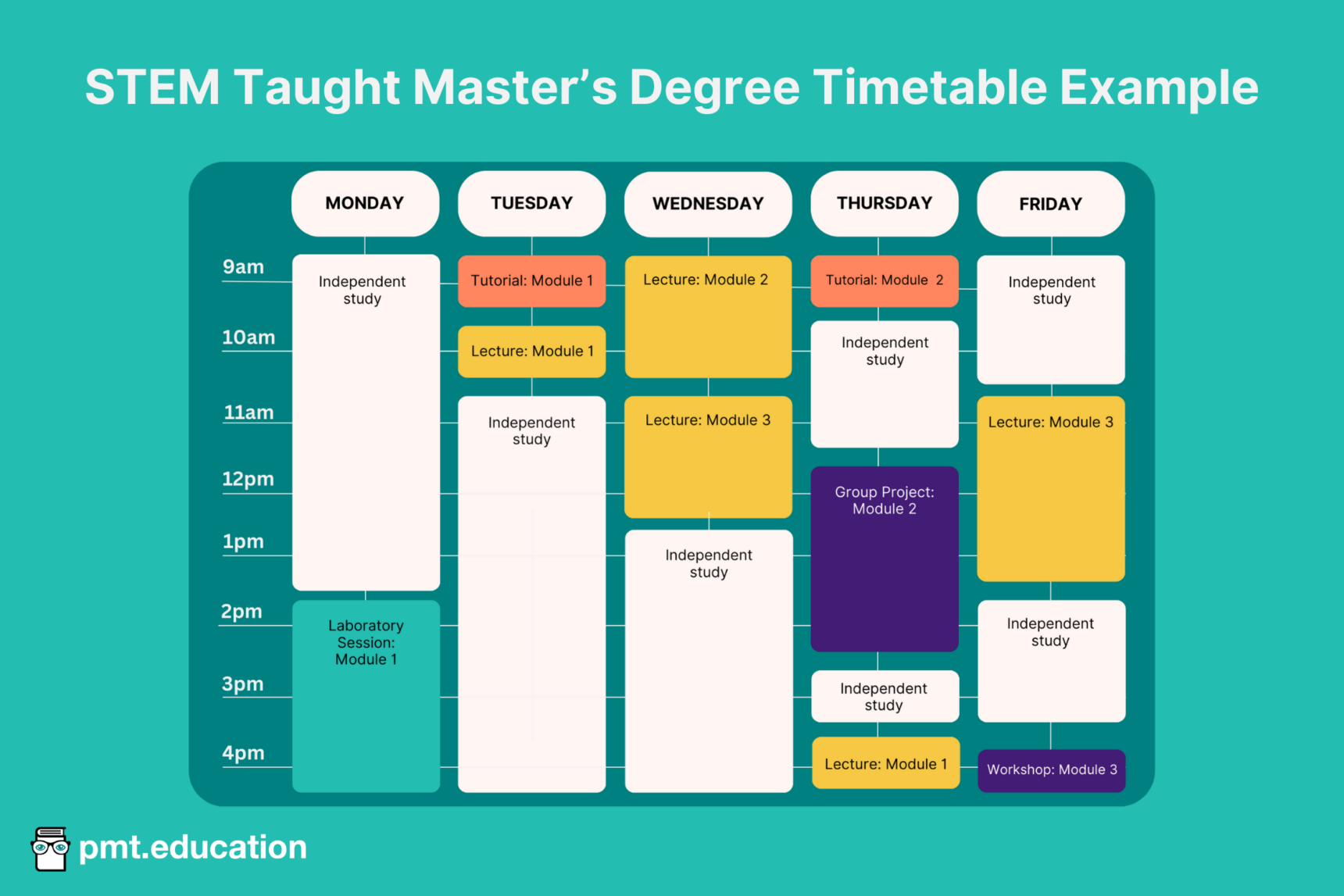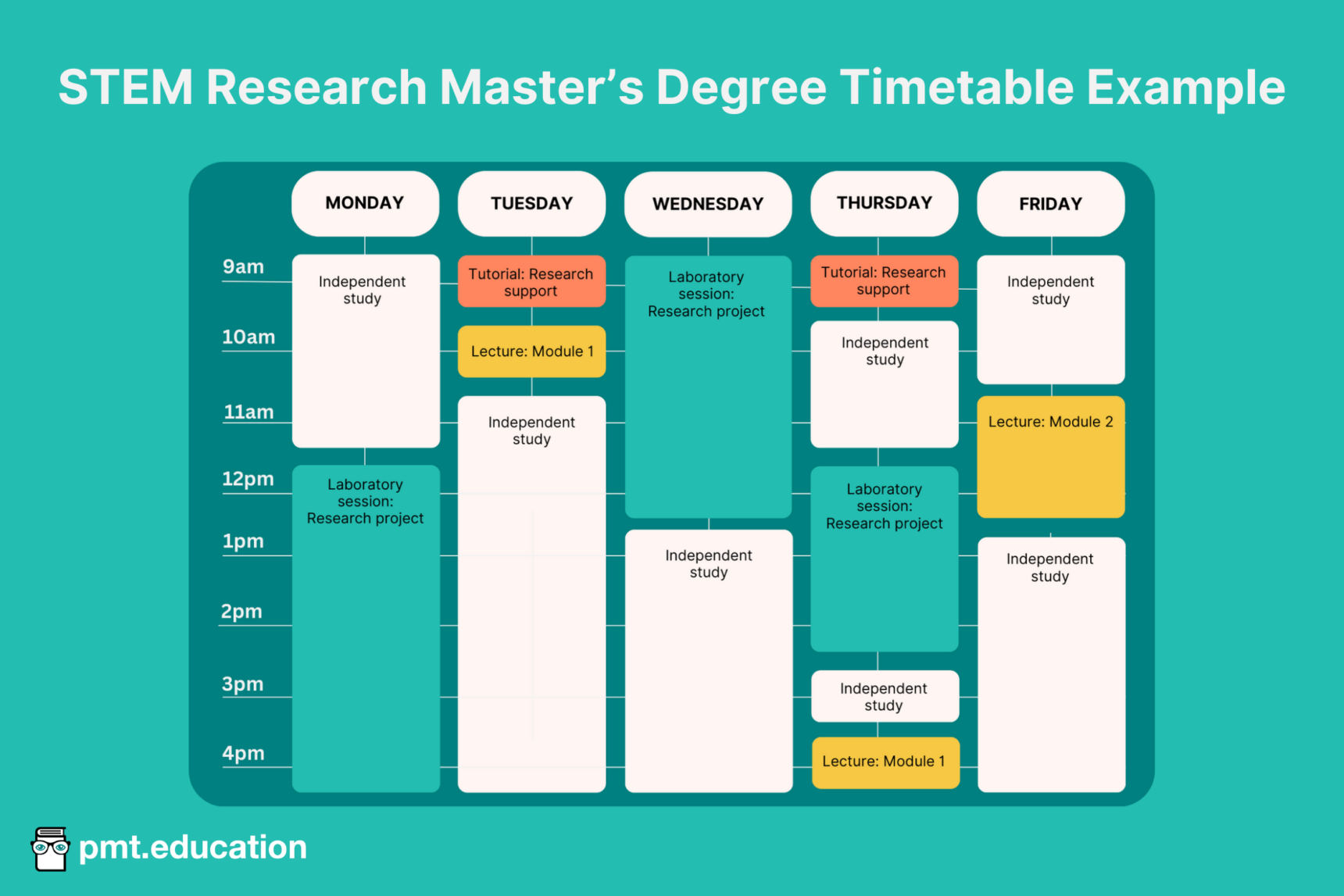Contents:
- What is a master’s degree?
- What is the difference between a master’s and an integrated master’s?
- What is the difference between a taught and research master’s?
- Before your master’s or integrated master’s degree
- During your master’s or integrated master’s degree
- After your master’s or integrated master’s degree
- Is a master’s degree worth it?
- FAQs
Qualification Level: Postgraduate (Level 7)
Entry Requirements: Bachelor’s degree in a related field
Cost: Tuition fees (vary by location of residence and location of study)
Assessment Methods: Exams, coursework, dissertation
Skills Developed: Advanced subject knowledge, research skills
Career opportunities: Enhanced career prospects, high potential for PhD
What is a master’s degree?
A master’s degree is the most common type of postgraduate qualification and follows on from a bachelor’s degree. STEM master’s degrees are designed for students who wish to deepen their expertise in a specific STEM field, advance into academia, or expand their career opportunities. As master’s are more specialised than bachelor’s degrees, there is a greater range of STEM master’s programmes available. This article explains the different master’s degrees available and guides you through the process from application to completion.
What is the difference between a master’s and an integrated master’s?
A STEM master’s degree can be taken as a separate postgraduate qualification after completing your bachelor’s degree or as an integrated master’s.
Integrated master’s programmes extend the usual bachelor’s degree by one year to cover both the undergraduate and postgraduate content in a single continuous course. You can apply for an integrated master’s directly from secondary school. This approach can provide a smoother transition between undergraduate and master’s studies, as you continue with the same group of students in a familiar environment.
What is the difference between a taught and research master’s?
Students can choose between taught or research (MRes) master’s degrees for most STEM fields. The terms ‘taught’ and ‘research’ master’s refer to the different learning methods used in the courses. As the name suggests, taught master’s degrees focus more on structured teaching, making them ideal for students seeking new or advanced knowledge. In contrast, research master’s degrees centre around an ongoing research project, making them suitable for those with a specific research question or pursuing a research-intensive career path. Both postgraduate and integrated master’s degrees have the option for either taught or research programmes, but most integrated masters fall into the taught category.
Before your master’s or integrated master’s degree
What master’s degrees are available in STEM?
As you have already seen, a master’s degree could be taught or research, and integrated or postgraduate. In addition to this, there is a wide range of STEM subjects available to study, which can be categorised into:
- Master of Science (MSc)
- Master of Engineering (MEng)
- Master of Technology (MTech)
- Master of Pharmacy (MPharm)
Examples of subjects within each of these categories can be seen in the table below.
Medical communications
Laboratory technician
Materials engineer
Food process engineer
Data scientist
Cybersecurity
Financial advisor
Maths teacher
Quality control scientist
Pharmaceutical marketing
Top tip
Always check the exact variation of the master’s course being offered, as the abbreviations used can vary from course to course:
- Taught master’s courses are usually referred to as MSc, MEng, MTech, or MPharm
- Integrated masters may be referred to as MSci
- Research master’s are referred to as MRes
Where can I find STEM master’s degrees?
There are two main methods for finding the STEM master’s degree that suits you best: searching university websites for courses offered by particular universities, or using comparison sites to see which universities offer a particular course. A popular comparison site to use is The Complete University Guide.
The method you choose should depend on which factor matters more to you: the university you attend or the course you study.
Top tip
If you are already at university, you may want to consider the master’s programmes offered by your university, as these often come with reduced tuition fees.
How do you apply for a master’s degree?
Applications for postgraduate master’s degrees are usually submitted in the final year of a bachelor’s degree. This differs for integrated masters, which secondary school students apply to in place of a bachelor’s. However, many individuals take gap years or time off before pursuing a master’s.

The common stages in the application process for STEM master’s degrees are:
- Narrowing your choices: The variety of master’s available leaves you with several decisions to make when narrowing down your master’s choices:
- Subject choice
- University and placement locations
- Integrated or postgraduate master’s degree
- Research or taught master’s degree
- Mode of study (online, in-person, full-time, or part-time)
- Meeting entry requirements: Ensure you meet the academic prerequisites, such as specific bachelor’s degree classifications or secondary qualifications for the integrated master’s.
- Submitting applications: Apply through the university’s application portal or UCAS.
- Supporting documents: Provide necessary documents, such as qualification transcripts, personal statements, and letters of recommendation. For research master’s programmes, you may also need to submit evidence of previous research projects.
- Entrance exams: Some programmes use admissions tests to select applicants.
- Interviews: Many universities will interview students before offering them a place on the programme, although this is less common if you are already studying at the university.
How can PMT Education support you with your master’s application?
- Detailed guidance on succeeding in the application process in our applying to study STEM at university article.
- A tuition platform with private university admissions tutors. There are tutors available for support with specific entrance exams, interviews, personal statements and finding scholarships and funding.
How much does a master’s degree cost?
The cost of master’s programmes varies greatly by country and university. In the UK, key expenses are similar to those seen for a bachelor’s degree:
- Tuition fees: Master’s degree tuition fees in the UK cost an average of £8,740 but can vary greatly between universities and courses. Fees are often higher for international students.
- Application costs: Applying to university through UCAS comes with an application fee. This may be waived for applicants from a lower income background.
- Additional costs: These may include books, equipment, laptops, printing, lab fees, and transport to placements.
- Exam costs: Most master’s degrees do not charge for examinations, but it’s important to check whether national examinations must be sat and their cost, particularly for vocational master’s programmes.
- Maintenance fees: Most students move away from home to study, so you should consider the cost of living, which includes rent, bills, food, travel, and leisure.

Funding options
The funding options available for master’s degrees include government tuition loans, as well as scholarships, bursaries, and grants.
For an integrated master’s degree, your undergraduate tuition loan of up to £9,250 per year is extended to cover your fourth year of study (you must clarify participation in an integrated master’s upon application for the loan). For a postgraduate master’s, postgraduate tuition loans are available up to £12,471 total, paid back as 6% of earnings over £21,000. Maintenance loans are not available to master’s students.
Return on investment
STEM master’s degrees can be considered an investment. As this article will demonstrate, master’s degrees are correlated with an 18% higher earning potential compared to undergraduate degrees. Although they are expensive to pursue, the expense is likely to be offset by a higher future income.
During your master’s or integrated master’s degree
A day in the life of a STEM master’s degree student
Master’s degrees differ significantly from bachelor’s degrees. They place a greater emphasis on independent learning, with students expected to spend 30-35 hours on independent study in addition to an average of 10 hours of contact time each week. You might receive a weekly timetable from the university, or in the case of a research master’s, you may be expected to schedule your hours to meet the demands of your research project. Example timetables for research and taught masters are shown below.
How is a STEM master’s degree assessed?
Assessment methods vary depending on the course. Research masters are assessed by an extended research project. Taught masters are assessed using a mixture of:
- Timed examinations
- Essays
- Group Work
- Presentations
- Laboratory reports
- End of degree thesis or dissertation
The grading system differs for integrated master’s and postgraduate master’s. An integrated master’s is obtained by completing 480 credits. You are assessed at the end of each year and your final grade is a combination of each year’s grades. Integrated master’s degrees are graded using the same system as bachelor’s:
- First-Class: 70%+
- Upper Second Class: 60–70%
- Lower Second-Class: 50–60%
- Third-Class: 45–50%
- Pass: 40–45%
- Fail: Below 40%
Postgraduate master’s are obtained by completing 180 credits. You are usually examined at the end of your course on everything you learned over the entire degree programme. Postgraduate master’s degrees are graded:
- Distinction: 70%+
- Merit: 60–69%
- Pass: 50–59%
- Fail: below 50%
After your master’s or integrated master’s degree
Outcomes of master’s vs undergraduate degree holders in STEM
Master’s graduates have higher employment rates, higher starting salaries, and faster career advancement. They are also more likely to progress to further study, such as PhDs. Moving directly from a bachelor’s degree to a PhD is rare. Take a look at our article on PhDs for more information.

Is a master’s degree worth it?
The benefits in earning potential, employability, and further education opportunities suggest a master’s degree is well worth the investment of time and money. However, none of these advantages are guaranteed. Whether a master’s degree is worthwhile depends heavily on how a master’s degree can help you achieve you’re goals.
| Advantages of a master’s degree | Disadvantages of a master’s degree |
|---|---|
| Higher earning potential | Higher tuition costs and lower student loan |
| Better job prospects | Extended study period |
| Specialised knowledge and skills | Intense workload |
| Networking opportunities | Potential student debt |
| Preparation for a PhD | Not always needed for a PhD |
| Required for specific job roles | Unnecessary for some job roles |
FAQs
Should I apply for a bachelor’s degree or an integrated master’s?
An integrated master’s is best suited to students who would like to continue studying a wide range of topics in their subject of choice and potentially go into a job in that area. However, you can switch between a bachelor’s and an integrated master’s once at university. So, is it best to apply to a bachelor’s and switch later, or vice versa? This heavily depends on your confidence in achieving the course entry requirements.
- If you are worried about meeting entry requirements, you might prefer to apply for the bachelor’s programme, as its entry requirements are usually lower than for the integrated master’s. Once you are at university, you can demonstrate your academic capabilities and then request to switch to an integrated master’s programme or request to switch on results day if you meet integrated master’s requirements.
- If you feel confident about meeting entry requirements, you might choose to apply directly to the integrated master’s programme. It is generally easier to switch down to a bachelor’s if you change your mind than to move up to an integrated master’s later.
Another factor to consider is whether a postgraduate master’s might be more suitable for you. For example, if you are unsure about your career goals or would like to specialise further after your bachelor’s, then applying for a postgraduate master’s could be a better fit. Postgraduate master’s programmes are often chosen later and tend to have a narrower focus.
What is the difference between MSc and MSci?
MSc is the abbreviation for a master’s in science, whilst the MSci is the abbreviation for an integrated master’s in science.
Can I change my mind about doing an integrated STEM master’s degree?
Before your third year of study in a bachelor’s degree, you can request to switch to an integrated master’s from a bachelor’s, or vice versa. However, once enrolled on a postgraduate master’s degree, you cannot switch to an integrated master’s as you have already completed your bachelor’s.
Additionally, if your second-year performance is not up to standard, you may be required to revert back to the bachelor’s programme. Most courses require a minimum grade of 55% or 60% to progress on the integrated master’s programme. This ensures that students can manage the more advanced content and workload of the final years.
What level is a master’s degree?
Qualifications are categorised into levels by the UK Government, with a master’s degree being classified as a Level 7 qualification.
How long is a master’s degree?
A separate, postgraduate master’s degree typically takes 1-2 years to complete, depending on the area of study. In contrast, an integrated master’s degree adds one additional year to your bachelor’s degree, resulting in a total of 4 years for a standard integrated master’s degree in the UK, or 5 years if it includes a placement year or year abroad.
Can I convert another qualification into a master’s degree?
Yes, other postgraduate qualifications can be ‘topped-up’ to obtain a master’s qualification. For example, Postgraduate Diplomas and Postgraduate Certificates can be transferred into a master’s qualification by taking additional modules or completing a dissertation to earn enough credits to meet the master’s credit requirements. This is common for PGCE’s which can be topped up to a master’s in education.



Comments